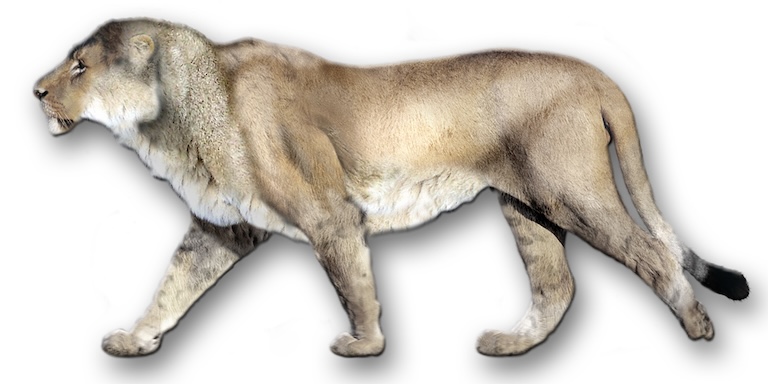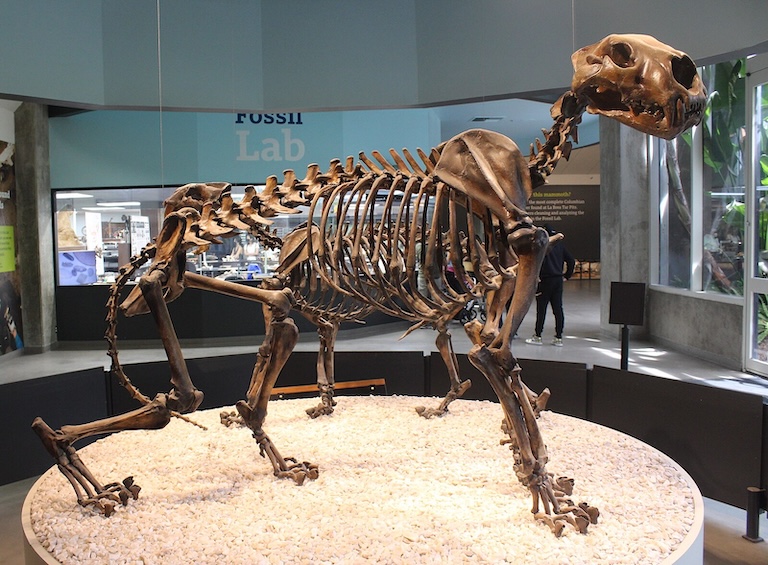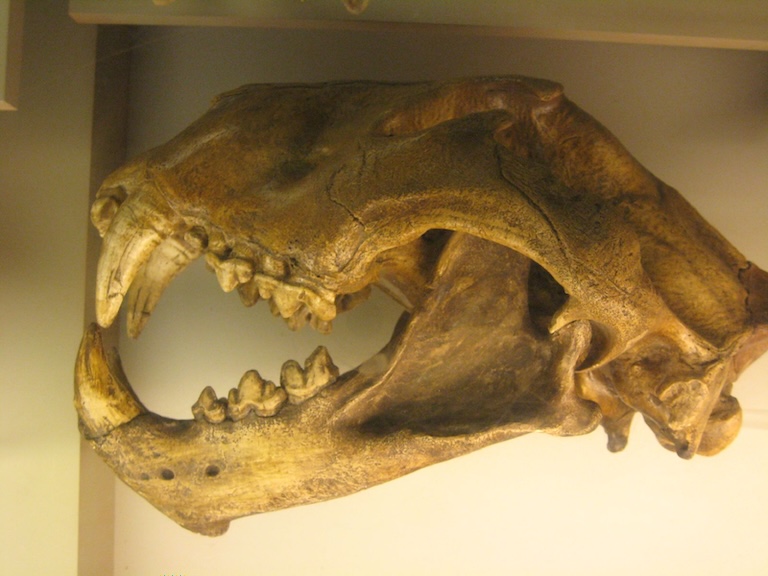American Lion Profile
American geography may have come a long way from the savanna and plains grasslands of its past,
but various tar pit traps and old caves give us clues to what it was once like across the continent.
North and South America was once home to numerous African-esque predators, and while the
American Lion might now sound more like a Weird Al cover of a Lenny Kravitz song, it was once
something our ancestors would have taken very seriously.

American Lion Facts Overview
| Habitat: | Open plains: savanna and grassland |
| Location: | North and South America |
| Lifespan: | Unknown |
| Size: | 2.5m (8’ 2”) long, 1.2m (4ft) tall |
| Weight: | Around 523kg |
| Color: | Possibly reddish skinned |
| Diet: | Large herbivores |
| Predators: | None |
| Top Speed: | Unknown |
| No. of Species: | 1 |
| Conservation Status: | Extinct |
The American lion is possibly more related to a jaguar than an extant lion, though it’s neither one nor
the other. This unique pantherine gets its scary name from the sheer size and power it must have
possessed.
This bear-sized cat would have had few competitors and was likely able to hunt prey alone or in
packs, and our understanding of the animal is still being supplemented by scant discoveries of remains ranging from Alaska to Patagonia.
Interesting American Lion Facts
1. An Atrocious Panther
The American lion is placed firmly inside the Panthera genus, which includes some of the most infamous cats in the world. Lions, tigers, leopards and jaguars – and their melanistic variety the panthers – all belong to this genus.
While there still exists an animal in North America known as a lion, the cougar is not one and belongs instead to the house cat family.
The species name atrox comes from the same root as the word for atrocity, meaning terrible, dreadful, frightening, and all that which palaeontologists love to apply to extinct monsters.
However, while the species’ name is well deserved, the common name might not be.
2. They’re probably not lions
For a long time, P. atrox was considered a subspecies of the existing lion, Panthera leo. But deeper assessments into the shape of its skull. They also had relatively longer legs compared with their skull size, suggesting they were well adapted to running. This adaptation seems to have occurred convergently with the African lion, in response to a very similar grassy plains environment.
While they have shown to resemble both jaguars and tigers, they appear to be unique from all extant Pantherines. This makes them a lot more exciting than a simple subspecies of lion; they were unique big cats, with their own adaptations, and as different from modern lions as tigers are now. 1

3. Entrapment bias
A huge number of the American lion remains known to science have come from tar pits, such as the Rancho La Brea tar traps in California.
These are bodies of natural tar into which countless animals fell, tens to hundreds of thousands of years ago, preserving their remains to be scooped up and investigated by modern researchers.
As such, there’s an inherent skewing of the data gathered from these remains: inexperienced or profoundly silly animals are going to have a much higher likelihood of becoming trapped than the wiser, smarter ones.
It’s also worth noting that while the small-brined Smilodon shows up in thousands of samples from tar pits, only around 80 North American Lions have been found. Whether this means they were less abundant or simply more intelligent remains unclear and is a perfect example of why selection biases like this are important to understand.
And in these traps, young male American lions are heavily over-represented; they would have been at dispersal age, when they leave their families to go and find new ones. So, what we know about their maximum size may represent a fraction of the truth.
And what we know about their size is already pretty terrifying. 2
4. They were bigger than tigers
Whatever they were, they were massive. These were lion-like cats that outweighed even the largest Pantherines alive today. Only the unholy monstrosities hybridised in so-called zoos, such as Tigrons and Ligers could have matched the American Lion in mass, and these are usually overweight and unhealthy animals.
P. Atrox, this fearsome lion, may have exceeded 523kg – close to 60% of that being skeletal muscle – and towered over modern lions by a further 25% (For reference, humans have an average of about 40% muscle, and content writers roughly half that).
This was a lion with almost twice the mass of a whole grizzly bear, and could more than hold its own against most predators of the age. Most, but not all. 3
5. Smilodon was a limiting factor
Their distribution is a little easier to assess, and the coexistence on the continent of the legendary Smilodon explains a lot about where and why the American lion evolved. The long legs of P. atrox likely evolved as an adaptation to savanna life.
While this big cat could have inhabited forest ecosystems, they were beaten to the punch by Smilodon whose fierce competition likely kept the American lion in its place, exclusively occupying open plains habitats. 4
6. A Patagonian Panthera
This is not to say, however, that the American Lion didn’t get around. While restricted to open plains, there was still a lot of real estate to go around and remains found as far south as Patagonia have been attributed to P. atrox.
This means that it shared modern-day Chile with one of the most terrifying mammals ever known: the “bear beast” Arctotherium. It’s known that one species of this bear would have occupied open and semi-arid habitats in Patagonia at the time, but fortunately for the American lions, this species was no bigger than they were.
The limited remains available do cloud the truth a little, but Patagonian finds in particular suggest that this cat inhabited caves, at least for denning. Skull fragments have even been found all the way up in the Yukon territory in Canada. 5 6

7. They went extinct around 10,000 years ago
The most recent fossils of these cats are tentatively dated at around 10,000 years ago, and it does seem that they, like so many other megafauna of the Pleistocene, disappeared around this time.
It’s not clear why this happened, but what we do know is that the climate was rapidly warming, and increased competition from human populations accelerated the extinctions of many of the large herbivores a predator of this size would have eaten.
Ultimately, the size and power of this incredible pantherine would have become its downfall, as prey reduction would have made maintaining its size very difficult. 7
American Lion Fact-File Summary
Scientific Classification
| Kingdom: | Animalia |
| Phylum: | Chordata |
| Class: | Mammalia |
| Order: | Carnivora |
| Family: | Felidae |
| Family: | Panthera |
| Family: | atrox |
Fact Sources & References
- Per Christiansen (2008), “Craniomandibular morphology and phylogenetic affinities of Panthera atrox: implications for the evolution and paleobiology of the lion lineage”, Journal of Vertebrate Paleontology.
- H. Todd Wheeler (2009), “Panthera atrox: body proportions, size, sexual dimorphism, and behavior of the cursorial lion of the North American plains”, Research Gate.
- WILLIAM ANYONGE (1992), “Body mass in large extant and extinct carnivores”, SciHub.
- H. Todd Wheeler (2009), “Panthera atrox: body proportions, size, sexual dimorphism, and behavior of the cursorial lion of the North American plains”, Publication.
- C. R. Harington (1969), “Pleistocene remains of the lion-like cat (Panthera atrox) from the Yukon Territory and northern Alaska”, Canadian Science Publishing.
- Nicolás R. Chimento (2017), “The fossil American lion (Panthera atrox) in South America: Palaeobiogeographical implications”, Science Direct.
- (2016) “American Lion”, Publication.
